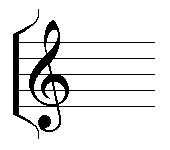 |
Here, the brace at the far left brackets together all the staves
which form a line or system of music.
Two staves like this are usually used for piano
music, when the top stave is normally for notes played with the right hand, and
the bottom stave is normally for notes played by the left hand. |
| Organ music requires three staves, two for the hands, as for piano music,
and an extra one added at the bottom for notes played on the pedals.
A brace is often used on the staves for the hands. |
 |
 |
When a four-part choir sings, they often read from four lines of music,
with parts for Soprano, Alto, Tenor and Bass, with the words written
underneath each line. Usually, each member of the choir has a full copy,
and reads only their own line.
In this example, the tenors sing an octave lower than written
(see clef).
Choirs with a different makeup, e.g. a male-voice choir, would have different
numbers of staves according to how many parts
are being sung, and different
clefs according to the different voices.
|
A four-part choir can also sing from "short-score":

Here, Soprano (S) and Alto (A) share the top stave, and Tenor (T) and Bass (B)
share the bottom. For more details, see the details of
parts. |
For a whole orchestra, the conductor reads from a full score,
but each member of the orchestra has a part which only gives their own line.
In a full score, the different instruments are arranged into their families,
so that all the strings are bracketed together, all the woodwind, and all the brass.
Then, if there is more than one part for a particular instrument, as in this example
for flutes, oboes and trumpets, they may be written on one stave or two. |
 |
|





 or:
or:
 or:
or:

